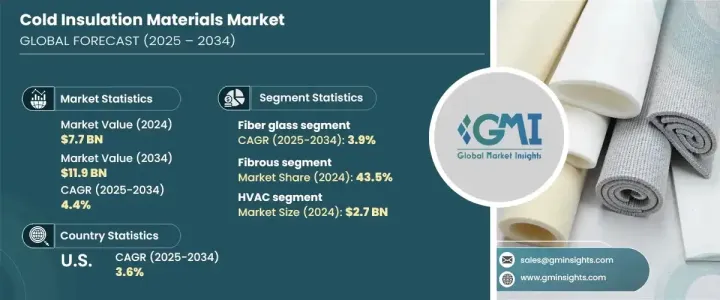
세계의 보냉재 시장은 석유 및 가스, 화학, 냉동 등 산업에서 수요 증가에 견인되어 안정적인 성장을 이루고 있습니다.
이러한 산업은 운영 효율성을 높이기 위해 저온 유지에 의존하고 있으며 고성능 단열재는 열 손실을 줄이고 에너지 소비를 최적화하는 데 필수적입니다. 2024년 시장 규모는 77억 달러로 평가되었고, 이 업계는 2025-2034년 연평균 복합 성장률(CAGR) 4.4%로 확대될 것으로 예측됩니다. 에너지 효율, 지속가능성, 비용 효율적인 온도 관리가 중시되고 있으며, 고급 저온 단열 솔루션의 채택이 가속화되고 있습니다.

엄격한 환경 규제 및 지속가능성에 대한 노력은 시장 확대를 더욱 강화하고 있으며, 산업계는 에너지 낭비를 최소화하는 단열재에 대한 투자를 촉구하고 있습니다. 기업은 가볍고 설치가 용이하면서도 내열성을 높이는 혁신적인 단열 솔루션 개발에 점점 더 힘을 쏟고 있습니다. 게다가 특히 제약업계 및 식품업계에서 저온 저장 시설에 대한 수요 증가도 시장 확대에 크게 기여하고 있습니다. 콜드체인 물류가 확대됨에 따라 제품의 무결성을 유지하고 에너지 손실을 방지하기 위한 신뢰할 수 있는 단열재의 필요성도 커지고 있습니다. 신흥경제국은 또한 급속한 산업화 및 인프라 정비에 의해 보냉재의 채용이 증가하고 있으며, 시장 확대에 있어 매우 중요한 역할을 하고 있습니다.
| 시장 범위 | |
|---|---|
| 시작 연도 | 2024년 |
| 예측 연도 | 2025-2034년 |
| 시작 금액 | 77억 달러 |
| 예측 금액 | 119억 달러 |
| CAGR | 4.4% |
유리 섬유는 2024년 34억 달러로 평가되었으며 예측 기간 동안 3.9%의 연평균 복합 성장률(CAGR)로 성장할 것으로 예상되며 보냉재 시장에서 지배적인 부문을 유지하고 있습니다. 탁월한 내열성으로 알려진 유리 섬유는 열 이동을 효과적으로 방지하기 위해 온도 관리가 중요한 용도 분야에서 선호되고 사용됩니다. 이 소재는 가볍고 유연한 특성을 가지므로 파이프, 탱크, 다양한 산업 기기에 원활하게 설치할 수 있어 수요를 더욱 촉진하고 있습니다. 산업계가 내구성 있는 고성능 단열 솔루션을 요구하는 가운데, 유리 섬유는 에너지 효율과 운영의 안정성을 높이는 능력으로 지지를 모으고 있습니다.
유리 섬유 및 미네랄 울을 포함한 섬유질 단열재 카테고리는 2024년 43.5%의 최대 시장 점유율을 차지했습니다. 이 소재는 뛰어난 열 성능과 다양한 용도에 대한 적응성으로 널리 알려져 있습니다. 섬유 단열재 내의 치밀한 공기 포켓 메시는 열전달을 현저하게 감소시켜 저온에 대한 최적의 보호를 보장합니다. 또한, 이러한 재료의 유연성을 통해 파이프라인이나 기계와 같은 복잡한 형상 주위에 쉽게 설치할 수 있어 열 손실에 대한 일관된 장벽을 만들 수 있습니다. 에너지 비용과 환경에 미치는 영향을 줄이는 것에 대한 관심이 높아짐에 따라 섬유질 단열재는 산업 및 상업용 용도 분야에서 중요한 구성 요소로 자리매김하고 있습니다.
2024년 21억 달러로 평가된 미국의 보냉재 시장은 CAGR 3.6%로 확대될 것으로 예상됩니다. 일부 지역의 가혹한 겨울을 포함한 변화가 풍부한 기후는 고성능 단열 솔루션 수요를 뒷받침하고 있습니다. 에너지 효율의 개선과 배출량의 삭감을 요구하는 규제 압력의 고조가, 산업계에 고도의 단열 기술 채용을 촉진하고 있습니다. 특히 상업 및 산업 건설 부문의 인프라에 대한 대규모 투자는 최첨단 단열 솔루션에 대한 수요를 더욱 높이고 있습니다. 산업계가 지속가능성 및 비용 효과를 우선시하는 가운데 미국 시장은 세계의 한랭지용 단열재 산업의 주요 기업로 지속적으로 혁신과 성장의 무대를 마련하고 있습니다.
The Global Cold Insulation Materials Market is experiencing steady growth, driven by increasing demand across industries such as oil and gas, chemicals, and refrigeration. These industries rely on maintaining low temperatures to enhance operational efficiency, making high-performance insulation materials essential for reducing heat loss and optimizing energy consumption. With a market value of USD 7.7 billion in 2024, the industry is projected to expand at a CAGR of 4.4% between 2025 and 2034. The rising emphasis on energy efficiency, sustainability, and cost-effective temperature management is accelerating the adoption of advanced cold insulation solutions.

Stringent environmental regulations and sustainability initiatives further fuel market expansion, prompting industries to invest in insulation materials that minimize energy waste. Companies are increasingly focusing on developing innovative insulation solutions that enhance thermal resistance while remaining lightweight and easy to install. Additionally, the growing demand for cold storage facilities, particularly in the pharmaceutical and food industries, contributes significantly to market growth. As cold chain logistics expand, so does the need for reliable insulation to maintain product integrity and prevent energy loss. Emerging economies are also playing a pivotal role in market expansion, with rapid industrialization and infrastructure development driving increased adoption of cold insulation materials.
| Market Scope | |
|---|---|
| Start Year | 2024 |
| Forecast Year | 2025-2034 |
| Start Value | $7.7 billion |
| Forecast Value | $11.9 billion |
| CAGR | 4.4% |
Fiberglass remains a dominant segment in the cold insulation materials market, valued at USD 3.4 billion in 2024 and expected to grow at a CAGR of 3.9% over the forecast period. Known for its exceptional thermal resistance, fiberglass prevents heat transfer effectively, making it a preferred choice in applications where temperature control is critical. The material's lightweight and flexible properties enable seamless installation in pipes, tanks, and various industrial equipment, further driving its demand. As industries seek durable, high-performance insulation solutions, fiberglass continues to gain traction for its ability to enhance energy efficiency and operational stability.
The fibrous insulation category, which includes fiberglass and mineral wool, held the largest market share of 43.5% in 2024. These materials are widely recognized for their superior thermal performance and adaptability across diverse applications. The dense network of air pockets within fibrous insulation significantly reduces heat transfer, ensuring optimal protection against cold temperatures. Additionally, the flexibility of these materials allows for easy installation around complex shapes, such as pipelines and machinery, creating a consistent barrier against heat loss. The growing focus on reducing energy costs and environmental impact positions fibrous insulation as a crucial component in industrial and commercial applications.
The U.S. cold insulation materials market, valued at USD 2.1 billion in 2024, is expected to expand at a CAGR of 3.6%. The country's varied climate, including harsh winters in several regions, drives the demand for high-performance insulation solutions. Increasing regulatory pressure to improve energy efficiency and reduce emissions has led industries to adopt advanced insulation technologies. Substantial investments in infrastructure, particularly within the commercial and industrial construction sectors, further bolster demand for cutting-edge insulation solutions. As industries prioritize sustainability and cost-effectiveness, the U.S. market remains a key player in the global cold insulation industry, setting the stage for continued innovation and growth.